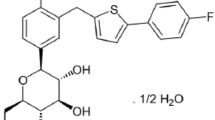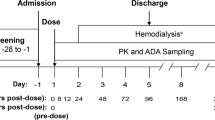Abstract
Background: Glibenclamide (Gb) may provoke long-lasting hypoglycaemic reactions, and one of the known risk factors is impaired renal function. We have demonstrated Gb to have a terminal elimination half-life of 15 h, and the main metabolites have a hypoglycaemic effect. With few exceptions, detailed studies on second generation sulphonylureas in diabetics with impaired renal function are lacking. Therefore, we analysed the pharmacokinetics of Gb and its active metabolites, 4-trans-hydroxyglibenclamide (M1) and 3-cis-hydroxyglibenclamide (M2) in this patient group.
Methods: Two groups of 11 diabetic patients with impaired renal function (IRF, iohexol clearance range 7–42 ml · min−1 · 1.73 m−2) or normal renal function (NRF, iohexol clearance range 75–140 ml · min−1 · 1.73 m−2) were compared. A single oral 7-mg dose of Gb was administered after overnight fasting. Serum samples and urine collections were obtained over 48 h and 24 h, respectively. Concentrations of Gb, M1 and M2 were determined by a sensitive and selective high-performance liquid chromatography assay.
Results: Peak serum values of M1 (24–85 ng · ml−1 vs 16–57 ng · ml−1), M2 (7–22 ng · ml−1 vs <5–18 ng · ml−1) and M1 + M2 (32–100 ng · ml−1 vs 23–76 ng · ml−1) were higher in the IRF group. AUC and Cmax of Gb were lower and the clearance to bioavailability ratio (CL/f) was higher in the IRF group. AUC and Cmax of M1 were higher and CL/f lower in the IRF group. Much lower amounts of M1 and M2 were excreted in the urine in the IRF group (7.2% vs 26.4% in 24 h). The fraction of the Gb dose excreted as metabolites (fe(met) 0–24 h), ranged between 0.005 and 0.36 and correlated significantly with renal function measured by iohexol clearance. No other pharmacokinetic differences were found.
Conclusion: The differences in AUC, Cmax and CL/f of Gb may be explained by a higher free fraction in the IRF group which would increase Gb metabolic clearance. The inverse findings regarding M1 may be explained by the fact that the metabolites are primarily eliminated by the kidneys. After a single dose of Gb, neither Gb, M1 nor M2 seemed to accumulate in diabetic subjects with IRF. As only small amounts of M1 and M2 were excreted in the urine, this indicates one or several complementary non-renal elimination routes, e.g. shunting of metabolised Gb to the biliary excretion route and/or enterohepatic recycling of both metabolites and unmetabolised Gb.
Similar content being viewed by others
Author information
Authors and Affiliations
Additional information
Received: 21 April 1997 / Accepted in revised form: 14 October 1997
Rights and permissions
About this article
Cite this article
Jönsson, A., Rydberg, T., Sterner, G. et al. Pharmacokinetics of glibenclamide and its metabolites in diabetic patients with impaired renal function. E J Clin Pharmacol 53, 429–435 (1998). https://doi.org/10.1007/s002280050403
Issue Date:
DOI: https://doi.org/10.1007/s002280050403




